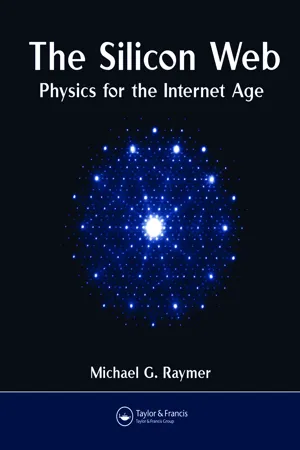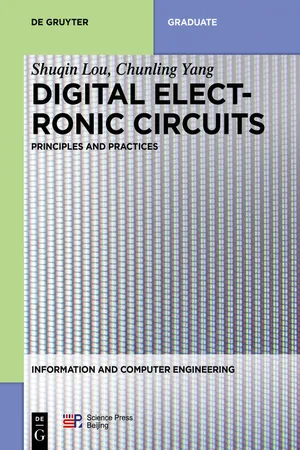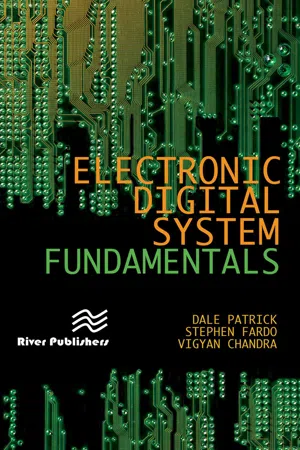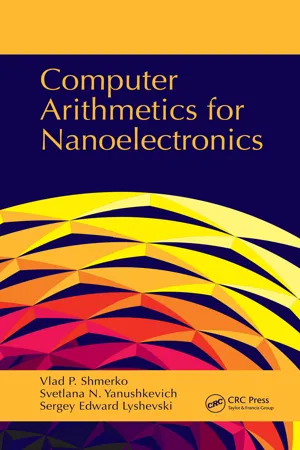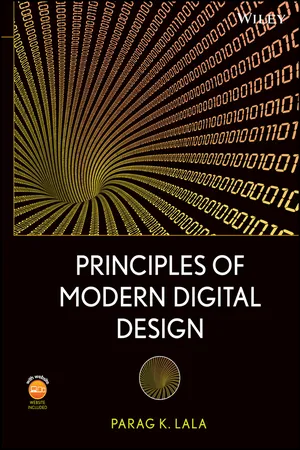Computer Science
Boolean Logic
Boolean logic is a fundamental concept in computer science that deals with the manipulation of true and false values. It is based on the principles of Boolean algebra, which uses logical operators such as AND, OR, and NOT to make decisions and perform calculations. Boolean logic forms the basis for programming and designing digital circuits.
Written by Perlego with AI-assistance
Related key terms
1 of 5
8 Key excerpts on "Boolean Logic"
- eBook - PDF
- S Sasti D Sasti(Author)
- 2019(Publication Date)
- Macmillan(Publisher)
1 Module 1 Topic 1: Principles of digital electronics for computing Boolean algebra and logic gates Module 1 Overview At the end of this module, you will be able to: • Unit 1.1: Demonstrate algebraic laws using Boolean algebra. • Unit 1.2: Translate Boolean expressions into logic diagrams and vice versa. • Unit 1.3: Use truth tables to represent Boolean expressions. • Unit 1.4: Use decision tables to simplify Boolean expressions. • Unit 1.5: Demonstrate knowledge of logic gates. • Unit 1.6: Demonstrate knowledge of the principles of logic devices. • Unit 1.7: Identify integrated circuits (ICs) that implement gates for computer systems. • Unit 1.8: Explain memory chips in terms of their use, functions and operational characteristics. Unit 1.1: Boolean algebra 1.1.1 Introduction You learned in Level 2 that computers are electronic devices made up of digital logic circuits that work on a sequence of ON or OFF switches. As programmers, we commonly refer to these switches as binary values represented by 1 or 0. Boolean algebra is a branch of mathematics based on logic . It has its own set of rules and laws which are used to analyse and simplify digital logic circuits. George Boole invented this logical way of analysing Boolean expressions to produce either a TRUE or FALSE result which can be represented by 1 or 0. 1.1.2 Boolean algebra Definition: Boolean algebra Boolean algebra is the algebra of logic. Boolean algebra operates using the logical operators on Boolean values. We will look at some of the Boolean algebraic laws and operations in this module. Logical operators Refer to Table 1.1 for a brief explanation of logical operators. Did you know? In 1847, George Boole introduced the idea of Boolean algebra and Boolean Logic in his first book, The Mathematical Analysis of Logic . His intention was to demonstrate how we can use mathematics to represent complex human reasoning in a logical way. This idea led to the design and logical working of computers. - eBook - PDF
The Silicon Web
Physics for the Internet Age
- Michael G. Raymer(Author)
- 2009(Publication Date)
- CRC Press(Publisher)
A simple example occurs in a calculator when you press the “add” or “ + ” button. The input data are the two numbers you want to add (18, 5). The calculator carries out several logical operations to produce the resulting sum (18 + 5 = 23), which is the output data. Before we consider the actual electronic circuits that perform the operations, we will discuss the principles behind logic. English mathematician George Boole (1815–1864) was one of the founders of the principles of logic. In his honor, the methods used are called Boolean Logic . In the context of modern computing, Claude Shannon was the most influential scientist who contributed to the theory of logic. In 1938, as a graduate student at Massachusetts Institute of Technology, he submitted his master’s thesis that showed how electronic circuits could be used to perform logic. Ten years later Shannon published the paper, “A Mathematical Theory of Communication,” which revolutionized scientists’ under-standing of the concept of information. 6.2 CONCEPTS OF LOGIC What is logic? In everyday life, it means to take in some information, apply certain rules of reasoning, and produce a decision. For example, you might reason that “if the sky is blue then I will take a walk without an umbrella, but if the sky is cloudy then I will take my umbrella.” The color of the sky is the input data and the umbrella decision is the output data. We can make a table showing our logic about the sky and umbrellas: Input: Sky blue? Output: Umbrella? No Yes Yes No The rules we use to process data or information are called logic operations . A logic operation is an elementary rule for arriving at a logical outcome. Three basic opera-tions that can serve as building blocks for all logic operations are NOT, AND, and OR. In considering complex situations, a diagram is useful to help visualize the logic process. Think of this as a flow chart for making a decision. - Available until 8 Feb |Learn more
- Raimund Swart(Author)
- 2024(Publication Date)
- Future Managers(Publisher)
112 Module 3 • Binary logic and Boolean algebra Introduction This section introduces binary logic and its significance in digital electronics and modern day computer systems. Binary logic gates are discussed and the functions they perform in binary logic operations. The binary number system is demonstrated with conversion methods between the binary and decimal number systems. Boolean algebra rules and De Morgan’s theorems are illustrated and supported by appropriate examples. The derivation of Boolean expressions for logic function block diagrams is explained, supported by the application of truth tables as a means of describing the functioning of a logic circuit. Various methods of simplifying Boolean expressions and logic function block circuits are demonstrated with examples. 3.1 Logic circuits Binary logic is a system that works with the binary digits “0” (zero) and “1” (one). Logic circuits are a network of symbols whose functions are manipulations of “0” and “1”, with the outcomes given as a “0” or “1”, depending on the specified function. A logic circuit can also be built with an electronic circuit where a physical closed switch represents a “1” and an open switch a “0”, or a high voltage (5V) represents a “1” and a low voltage (0V) a “0”. Definition Binary logic – a two-valued logic with a set of rules dealing with propositions that must either be true or false The binary number system has the base of 2 and it has only two digits namely “0” and “1”, whereas the decimal system has the base of 10 and it has ten digits, 0 to 9. The binary system is used in computer programming and electronic circuits because it can be simulated with electronics, where a “1” is represented by an “on” condition and a “0” by an “off ” condition. Calculations can be performed electronically in the binary number system and the answers then displayed in the decimal number system, which we are all used to. The conversion method is discussed in a later section. - eBook - PDF
Digital Electronic Circuits
Principles and Practices
- Shuqin Lou, Chunling Yang(Authors)
- 2019(Publication Date)
- De Gruyter(Publisher)
3 Boolean algebra and logic simplification 3.1 Introduction Digital system belongs to a two-valued algebraic system which was invented by an Irish logician and mathematician, George Boole, in 1854 [18]. Now a two-valued algebraic system is usually called Boolean algebra or logical algebra. Boolean algebra is to formulate logic statements with symbols so that problems can be written and solved in a manner similar to ordinary algebra. Shannon was the first person to apply Boole ’ s work to analyze and design logic circuit in 1938. Today, Boolean algebra has already become a convenient and systematic way of analyzing and designing digital circuits. Boolean algebra involves a large amount of content. In this chapter, we only introduce the limited content in Boolean algebra required for digital circuits. This chapter covers the laws, the rules, and the theorems of Boolean algebra for the requirement of digital circuits. You will learn how to simplify logic expressions using the methods of Boolean algebra and Karnaugh map. The objectives of this chapter are to – Apply basic laws, rules, and theorems of Boolean algebra – Define AND, OR, NOT operation – Describe logic function of three basic logic gates including inverter, AND gate, OR gate – Explain the combinational operation NAND, NOR, XOR, or NXOR – Explain standard sum-of-product expression and standard product-of-sum expression – Simplify Boolean expressions using Boolean algebra – Apply Karnaugh map to simplify logic expression 3.2 Boolean operations and logic gates Boolean algebra is a mathematics tool for digital circuit and system. This section mainly introduces basic knowledge of Boolean algebra, several commonly used logical operations and logic gates. Logic symbols used to represent the logic gates are in accordance with the ANSI/IEEE Standard 91-1984 in the whole book [19]. - eBook - PDF
- Dale R. Patrick, Stephen W. Fardo, Vigyan Chandra(Authors)
- 2020(Publication Date)
- River Publishers(Publisher)
Chapter 3 Boolean Algebra and Logic Gates INTRODUCTION Digital electronics operates on a mathematical base as do other forms of electronics. The operating principle of a digital electronic system is quite unique when compared with other electronic functions. Digital electron-ics, for example, is concerned with two-state information represented by bits. A bit may assume either one of two values: 0 or 1. The operational base of this system is considered to be binary, or base 2. Boolean algebra is the mathematical basis of digital logic because it responds to base 2 infor-mation. Boolean algebra is an important tool when used in the digital elec-tronics field. It is used to express logic functions in the form of an equa-tion, to analyze data, to simplify logic expressions, to design logic circuits and to troubleshoot a logic circuit. A person working with digital logic cir-cuits continually uses Boolean algebra. USING BOOLEAN ALGEBRA In 1854 George Boole, an Englishman, published a paper titled “An Investigation of the Laws of Thought.” In this publication, Boole symbol-ized the form of algebra that deals with two-state logic. In 1938 Claude Shannon, an American, wrote a paper titled “A Symbolic Analysis of Relay and Switching Circuits.” This paper applied Boole’s ideas to relay switch-ing used in telephone circuitry. Today, this is called Boolean algebra. It is based on standard algebraic principles that deal with the mathematical theory of two-state logic. The notations of Boolean algebra and theorems are fundamental in the study of digital electronics. Boolean algebra is a special form of algebra that was designed to show the relationships of two-state variable logic operations. 49 50 Electronic Digital System Fundamentals This form of algebra is ideally suited for the analysis and design of binary logic systems. Through the use of Boolean algebra, it is possible to write mathematical expressions that describe specific logic functions. - eBook - PDF
- Vlad P. Shmerko, Svetlana N. Yanushkevich, Sergey Edward Lyshevski(Authors)
- 2018(Publication Date)
- CRC Press(Publisher)
6 Foundation of Boolean Data Structures 6.1 Introduction Binary arithmetic provides a number possibilities for the manipulation of binary numbers. However, the design of devices for operation of binary data requires the detail, formal description of the manipulation. In 1854, about a century before the advent of modern computers, George Boole developed the theory of logical calculus, which has become known as Boolean algebra . He set forth a system of axioms and theorems on true–false relationships. If true is represented by 1 and false by 0, Boolean algebra can be applied to data representation and processing. In 1938, Claude Shannon applied Boolean algebra to Boolean circuit design. The basic element of these circuits was a switch that can be in one of two states: open or closed. Boole’s theorems and Shannon’s techniques help us design logic networks for calculations binary numbers. This particular form of Boolean algebra is called switching theory . Boolean algebra is a universal data structure in the sense that (a) an arbitrary operations and manipulation of binary numbers can be represented in terms of Boolean algebra, and (b) this representation is technology independent, that is, it can be applied for description of any data structure independently of the underlying physical and chemical phenomena. However, various Boolean data structures based on the formalism of Boolean algebra can be developed with respect to the requirements of the technologies and fabrication. There are various algebras that are an extension or generalization of Boolean algebra, for example, probabilistic logic, fuzzy logic, and multivalued logic. In this chapter, we introduce the basic aspects of Boolean algebra that are used in Boolean data structure construction. - No longer available |Learn more
- (Author)
- 2014(Publication Date)
- Learning Press(Publisher)
Shannon already had at his disposal the abstract mathematical apparatus, thus he cast his switching algebra as the two-element Boolean algebra. In circuit engineering settings today, there is little need to consider other Boolean algebras, thus switching algebra and Boolean algebra are often used interchangeably. Efficient implementation of Boolean functions is a fundamental problem in the design of combinatorial logic circuits. Modern electronic design automation tools for VLSI circuits often rely on an efficient representation of Boolean functions known as (reduced ordered) binary decision diagrams (BDD) for logic synthesis and formal verification. ________________________ WORLD TECHNOLOGIES ________________________ Logic sentences that can be expressed in classical propositional calculus have an equivalent expression in Boolean algebra. Thus, Boolean Logic is sometimes used to denote propositional calculus performed this way. Boolean algebra is not sufficient to capture logic formulas using quantifiers, like those from first order logic. Although the development of mathematical logic did not follow Boole's program, the connection between his algebra and logic was later put on firm ground in the setting of algebraic logic, which also studies the algebraic systems of other many other logics. The problem of determining if the variables of a given Boolean (propositional) formula can be assigned in such a way as to make the formula evaluate to true is called the Boolean satisfiability problem (SAT), and is of importance to theoretical computer science, being the first problem shown to be NP-complete. The closely related model of computation known as a Boolean circuit relates time complexity (of an algorithm) to circuit complexity. Values Whereas elementary algebra deals mainly with real numbers, Boolean algebra deals with the values 0 and 1. These can be thought of as two integers, or as the truth values false and true respectively. - eBook - PDF
- Parag K. Lala(Author)
- 2007(Publication Date)
- Wiley-Interscience(Publisher)
2 Fundamental Concepts of Digital Logic 2.1 INTRODUCTION The objective of this chapter is to familiarize readers with the basic concepts of set theory, relations, graphs, and Boolean algebra. These are necessary to understand material pre-sented in later chapters. Boolean algebra is used for the analysis and design of electrical switching circuits (popularly known as digital logic circuits). We are mainly interested in the application of Boolean algebra in constructing digital circuits using elements called gates . 2.2 SETS A set is a collection of objects. The objects comprising a set must have at least one prop-erty in common — for example, all male students in a class, all integers less than 15 but greater than 5, or inputs to a logic circuit. A set that has a fi nite number of elements is described by listing the elements of the set between brackets. Thus the set of all positive integers less than 15 but greater than 5 can be written {6, 7, 8, 9, 10, 11, 12, 13, 14} The order in which the elements of a set are listed is not important. This set can also be represented as follows: {9, 10, 6, 7, 14, 13, 8, 11, 12} In general, uppercase letters are used to represent a set and lowercase letters are used to represent the numbers (or elements) of a set. If a is an element of a set S , we represent that fact by writing a ∈ S On the other hand, if a is not an element of S , we can indicate that by writing a ∉ S For example, if S = 5, 7, 8, 9 , then 5 ∈ S , 7 ∈ S , 8 ∈ S , and 9 ∈ S , but 6 ∉ S . 29 Principles of Modern Digital Design , by Parag K. Lala Copyright © 2007 John Wiley & Sons, Inc. A set may have only one element; it is then called a singleton . For example, 6 is the set with 6 as its only element. There is also a set that contains no element; it is known as the empty or null set and is denoted by ∅ . A set may also be de fi ned in terms of some property that all members of the set are required to have.
Index pages curate the most relevant extracts from our library of academic textbooks. They’ve been created using an in-house natural language model (NLM), each adding context and meaning to key research topics.

